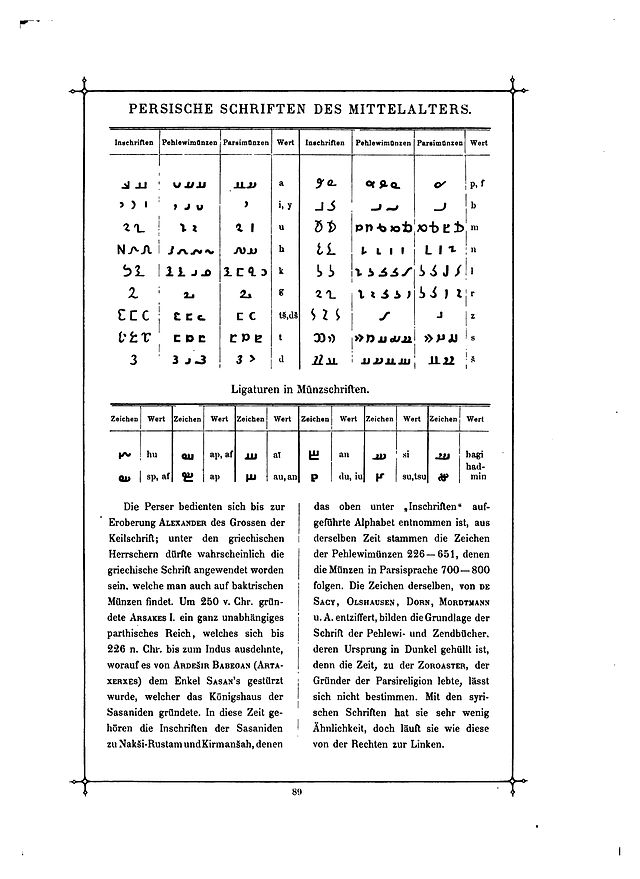Inscriptional Pahlavi
Earliest attested form of Pahlavi scripts From Wikipedia, the free encyclopedia
Inscriptional Pahlavi is the earliest attested form of Pahlavi scripts, and is evident in clay fragments that have been dated to the reign of Mithridates I (r. 171–138 BC). Other early evidence includes the Pahlavi inscriptions of Parthian coins and the rock inscriptions of Sasanian emperors and other notables, such as Kartir the High Priest.
| Inscriptional Pahlavi | |
|---|---|
 Inscribed stone block from the Paikuli inscription | |
| Script type | |
Time period | 2nd century BC — 6th century AD |
| Direction | Right-to-left script |
| Languages | Middle Iranian languages |
| Related scripts | |
Parent systems | Aramaic alphabet
|
| ISO 15924 | |
| ISO 15924 | Phli (131), Inscriptional Pahlavi |
| Unicode | |
Unicode alias | Inscriptional Pahlavi |
| U+10B60–U+10B7F | |

Letters
Inscriptional Pahlavi used 19 non-joining letters:[1][2]
| Name[A] | Image | Text | Phones (IPA; Middle Persian)[3] | Transliteration[1] |
|---|---|---|---|---|
| Aleph | 𐭠 | [a], [aː] | ʼ | |
| Beth | 𐭡 | [b], [w] | b | |
| Gimel | 𐭢 | [ɡ], [j] | g | |
| Daleth | 𐭣 | [d], [j] | d | |
| He | 𐭤 | — | h | |
| Waw-Ayin-Resh | 𐭥 | [w], [o(ː)], [u(ː)], [∅], [r] | w | |
| Zayin | 𐭦 | [z] | z | |
| Heth | 𐭧 | [h], [x] | ḥ | |
| Teth | 𐭨 | — | ṭ | |
| Yodh | 𐭩 | [j], [e(ː)], [i(ː)], [d̠͡ʒ] | y | |
| Kaph | 𐭪 | [k], [ɡ] | k | |
| Lamedh | 𐭫 | [l], [r] | l | |
| Mem-Qoph | 𐭬 | [m] | m | |
| Nun | 𐭭 | [n] | n | |
| Samekh | 𐭮 | [s], [h] | s | |
| Pe | 𐭯 | [p], [b], [f] | p | |
| Sadhe | 𐭰 | [t̠͡ʃ], [d̠͡ʒ], [z] | ṣ | |
| Shin | 𐭱 | [ʃ] | ś/š | |
| Taw | 𐭲 | [t], [d] | t |
Numbers
Inscriptional Pahlavi had its own numerals:
Numbers are written right-to-left. Numbers without corresponding numerals are additive. For example, 24 is written as 𐭽𐭻 (20 + 4).[1]
Unicode
Inscriptional Pahlavi script was added to the Unicode Standard in October, 2009 with the release of version 5.2.
The Unicode block for Inscriptional Pahlavi is U+10B60–U+10B7F:
| Inscriptional Pahlavi[1][2] Official Unicode Consortium code chart (PDF) | ||||||||||||||||
| 0 | 1 | 2 | 3 | 4 | 5 | 6 | 7 | 8 | 9 | A | B | C | D | E | F | |
| U+10B6x | 𐭠 | 𐭡 | 𐭢 | 𐭣 | 𐭤 | 𐭥 | 𐭦 | 𐭧 | 𐭨 | 𐭩 | 𐭪 | 𐭫 | 𐭬 | 𐭭 | 𐭮 | 𐭯 |
| U+10B7x | 𐭰 | 𐭱 | 𐭲 | 𐭸 | 𐭹 | 𐭺 | 𐭻 | 𐭼 | 𐭽 | 𐭾 | 𐭿 | |||||
| Notes | ||||||||||||||||
Gallery
- Inscriptional Pahlavi text from Shapur III at Taq-e Bostan, 4th century
- Kartir's inscription at Naqsh-e Rajab
- Coin of Ardashir I (r. 224–42) with Inscriptional Pahlavi writings
References
Wikiwand - on
Seamless Wikipedia browsing. On steroids.




